Prolonged Fasting vs. 16:8 Fasting Compared – Which Is Better?
There are many reasons why people would start a fasting protocol, but many struggle with hunger pangs. The obvious choice that comes to mind when you feel hungry while fasting is to eat, but that violates the basic rule of fasting.
We have a few ideas you can use to feel less hungry and to comfortably keep on fasting. No matter your reason for fasting, you need to be determined to stick with it until your fasting window is over. Here’s how to fast without hunger and reach your goal for a healthier life.

Health Reporter has been looking into the best method of fasting for a range of different health issues, as well as simply looking to lose weight.
We narrowed our search to two of the most popular fasting diets, the 16:8 method, and prolonged fasting. Our aim is simple – which of these diets is the best?
YouGov recently found that 24% of Americans have tried fasting due to the inexpensiveness and accessibility of the diet.
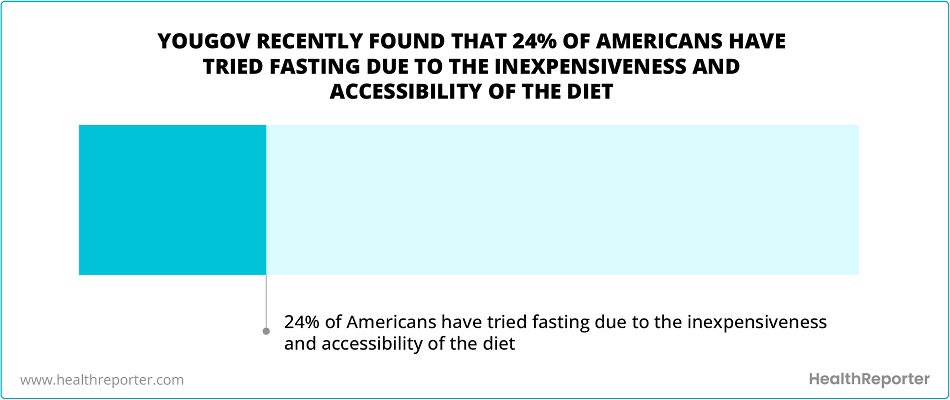
So let’s jump in and see which method of fasting will be crowned our champion:
Key findings:
- 24% of Americans have tried fasting due to it being affordable and accessible.
- The longest fast ever recorded stands at 382 days.
- 79% of weight loss was owing to loss of fat specifically.
- Short-term intermittent fasting helps speed up your metabolism by as much as 14%.
What Is a Fast?
Simply put, it means you stop eating altogether, or almost wholly, for a specific period. A fast usually lasts from 12 to 24 hours, but some types continue for days at a time. In some cases, you may be allowed water, tea, coffee, or even a tiny amount of food during the “fasting period.”
Besides religious practice, there are a number of health reasons. First, as you might guess, is weight loss. There’s also research showing that certain types of fasting may help improve your cholesterol, blood pressure, glucose levels, insulin sensitivity, and other health issues.
The human body has adapted to withstand long periods of food deprivation, with the longest fast ever recorded lasting 382 days.

What Is Prolonged Fasting?
Prolonged fasting is an extreme form of caloric restriction that lasts for two days or more. Usually, it lasts anywhere between 2–5 days to a maximum of two weeks and is only broken by the consumption of water and plain tea or coffee.
All of these terms are synonyms for the same thing – a seemingly simple process of not eating for an extended period. Usually, it means no food intake for anywhere from 24 hours to multiple consecutive days.
You might be asking: Why would you choose to “starve” yourself for days? Is prolonged fasting safe? What prolonged fasting results should you expect?
For those new to fasting, it is recommended that you practice intermittent fasting (IF) of increasing lengths before trying prolonged fasting, as your body becomes adjusted to ketosis.
For example, start out with the 12:12 intermittent fast before moving on to a 24-hour fast and finally a two-day prolonged fast.
What Is 16:8 Fasting?
The practice of 16:8 intermittent fasting involves limiting your intake of foods and calorie-containing beverages to a set window of 8 hours per day. You abstain from food for the remaining 16 hours, though you’re still allowed to drink water and other no-calorie beverages, like plain coffee or tea.
You can repeat this cycle as frequently as you’d like – from just once or twice per week to every day, depending on your preference.
The popularity of this fasting method has grown widely among those looking to lose weight and burn fat. 16:8 intermittent fasting is also believed to improve blood sugar control and enhance longevity.
While other diets often set strict rules, 16:8 intermittent fasting is easy to follow and may provide measurable results with minimal disruption to your diet. It’s generally considered less restrictive and more flexible than many other diets and works with most lifestyles.
Managing Weight Loss – 16:8 vs. Prolonged Fasting
Fasting is one of the most popular diet trends used around the world, with the end goal being to lose weight. By having days where you restrict your eating and calorie intake, you also reduce cravings and avoid temptations.
16:8 diet – weight loss
For the 16:8 fasting method, in all 27 trials, intermittent fasting resulted in weight loss, ranging from 0.8% to 13.0% of baseline body weight.

Weight loss occurred regardless of changes in overall caloric intake. In the 16 studies of 2 to 12 weeks duration that measured BMI, BMI decreased, on average, by 4.3% to a median of 33.2kg (73lbs)/m2. Waist circumference decreased by 3cm to 8cm in studies longer than 4 weeks that recorded it.

Most of the weight loss with IF is fat loss. A 2011 study by Harvie et al. calculated that 79% of weight loss was due to fat loss specifically.
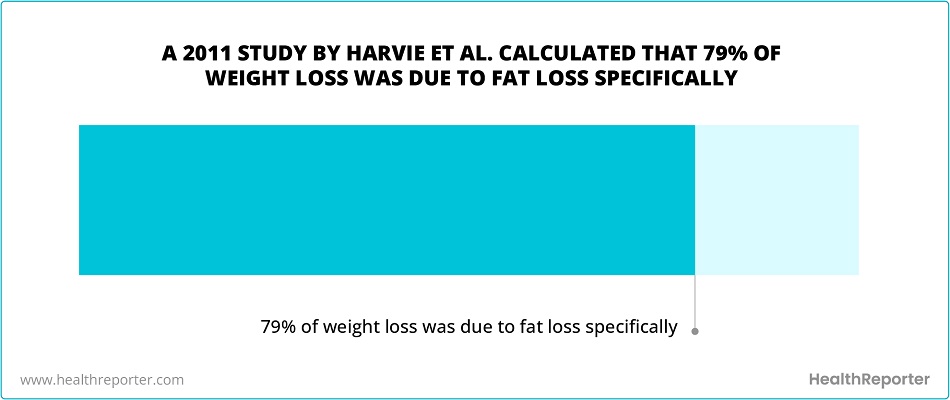
Participants regained some weight during follow-up after the intervention, although average body weight remained statistically significantly lower than baseline levels.
Weight regain did occur after 6 months. Five studies followed participants for 6 months or longer after completing IF interventions of 8 weeks to 1 year, and most studies saw body weight increase by 1% to 2% of their weight.
Intermittent fasting shows promise for the treatment of obesity. To date, the studies have been small and of short duration. Longer-term research is needed to understand the sustainable role intermittent fasting can play in weight loss.
Unlike calorie-restricted diets, short-term intermittent fasting helps speed up your metabolism by as much as 14%, according to research.
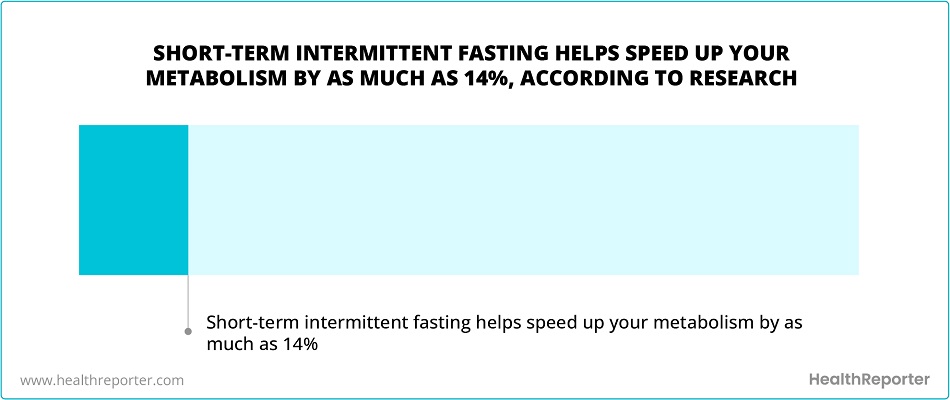
It does this by causing a rise in norepinephrine, a stress hormone responsible for releasing fatty acids from fat cells and making larger amounts of fat available for the body to burn.
The faster your metabolic rate, the more calories you’ll burn by doing basic activities like sitting down, eating, and sleeping. Exercise is also encouraged during intermittent fasting, which, in turn, helps with hanging onto and building muscle mass – another essential way to boost your metabolism.
Prolonged fasting – weight loss
Prolonged fasting can promote weight loss, reduce abdominal fat, and improve blood pressure levels, even in those who are already at a healthy weight.
It is not a quick weight loss fix and should be repeated regularly, for example, once a month, in order to see the physical results of long-term weight loss. Prolonged fasting has an advantage over short intermittent fasts in that it induces autophagy, the process of cellular rejuvenation. Autophagy is an ongoing cellular process in which cells reuse their damaged organelles to renew.
It is also used during nutrient stress to balance available energy sources for survival and can be triggered by caloric restriction. Around 24 hours into a prolonged fast, nutrient-sensing pathways repress the TOR kinase protein in response to nutrient deprivation, inducing autophagy.
The cell renewal from autophagy is thought to protect against age-related diseases like neurodegeneration, cardiomyopathy, diabetes, and cancer, as well as increase longevity. Autophagy reaches its highest level around day two of a prolonged fast, so it is more difficult to achieve using shorter intermittent fast methods.
An obvious drawback to prolonged fasting is the constant hunger that accompanies sustained calorie restriction. Considering that most prolonged fasts only allow the consumption of water, tea, and coffee, it is a method that requires serious commitment and motivation. However, our bodies can adapt to hunger, and one study found that 93% of subjects reported an absence of hunger.
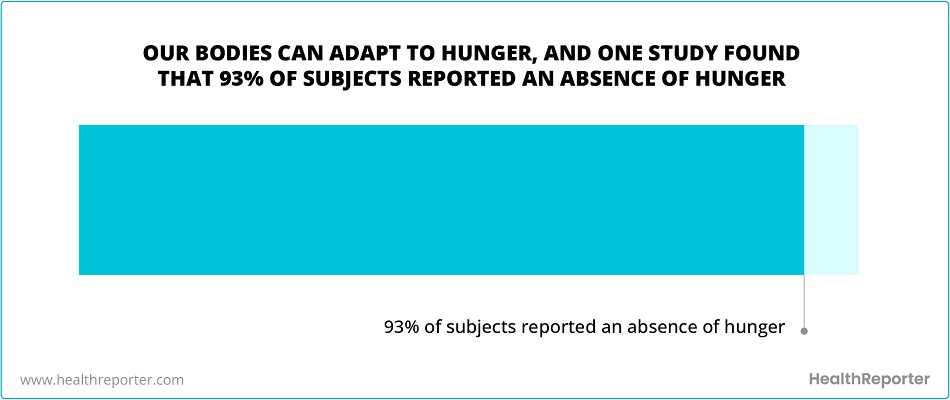
While prolonged fasting is generally safe, it is one of the riskier methods of caloric restriction that can be accompanied by mild side effects, including dehydration, electrolyte imbalance, and fatigue. Users also may experience irritability and low energy as the body transitions into ketosis.
This can be countered by taking sensible measures such as increasing your water intake, adding 0.5–1 teaspoon of sea salt to drinking water to prevent electrolyte depletion, and taking regular rest.
Overall, we believe that the better form of fasting to lose weight is the 16:8 method. There have been multiple studies into this, and all of them suggest that the subjects have all lost reasonable weight. Prolonged fasting is also shown to improve weight loss, but due to the more extreme nature of fasting and the higher chance of risk, the 16:8 method is triumphant.
Autophagy – 16:8 vs. Prolonged Fasting
Autophagy is the body’s way of cleaning out damaged cells, in order to regenerate newer, healthier cells, according to Priya Khorana, Ph.D. in Nutrition Education and Exercise Physiology from Columbia University.
“Auto” means self, and “phagy” means eat. So the literal meaning of autophagy is “self-eating.”
It’s also referred to as “self-devouring.” While that may sound like something you never want to happen to your body, it’s actually beneficial to your overall health.
This is because autophagy is an evolutionary self-preservation mechanism through which the body can remove the dysfunctional cells and recycle parts of them for cellular repair and cleaning.
16:8 fasting – autophagy
In addition to exercise or restrictive eating, intermittent fasting is one of the best ways to induce autophagy. However, waiting just a few hours between meals does not translate to immediate autophagy time. Your body requires low liver glycogen to enter this phase, which requires a 14–16-hour fast.
In a study of autophagy and fasting, researchers from the Taylor & Francis Group found short-term fasting periods of 24 hours resulted in a marked increase in the number of cells undergoing autophagy. You may benefit from a 5-day fast for autophagy if you’re experienced with extended fasting and withstand more prolonged periods.
According to biochemist Valter Longo of the University of Southern California in Los Angeles, following a 5-day fast can fight disease and slow aging by increasing the body’s rate of autophagy. However, autophagy does start sooner, so a more realistic 16:8 fast is likely the best place to begin.
Prolonged fasting – autophagy
Depending on the individual’s metabolism, significant autophagy may take 2–4 days of fasting in humans. Autophagy is believed to begin when glucose and insulin levels drop considerably. Animal studies have shown evidence of autophagy after 24 hours of fasting, which starts peaking at around 48 hours of fasting.
Some studies have detected autophagy in human cultured neutrophils (the most abundant type of immune cell in the blood) after 24 hours. There are, however, no conclusive studies on humans that indicate an optimal period of fasting to achieve autophagy. However, do not attempt too fast to induce autophagy without discussing this method with your doctor.
Clinical research indicates that long-term calorie restriction (3–15 years) leads to an increased expression of autophagy genes and higher levels of molecules involved in removing dysfunctional proteins and organelles. It’s widely accepted that both CR and fasting may lead to improved health and longevity, and autophagy likely plays a key role in this.
The current evidence suggests that anywhere between 18 hours (as evidenced by the eTFR study) to 4 days will trigger autophagy. However, only a handful of studies measuring fasting and autophagy exist in humans. As mentioned above, intermittent fasting, calorie restriction, and exercise are all ways to boost autophagy that don’t involve fasting for several days.
We have determined that prolonged fasting is the fasting method of choice when looking to achieve autophagy. Seeing as the effects are rumored to occur after 18 hours of fasting right up to 4 days, it suits prolonged fasting far better. While there are benefits for autophagy using the 16:8 method, prolonged fasting is a much better solution and wins this round.
Reducing Inflammation – 16:8 vs. Prolonged Fasting
Intermittent fasting and related fasting methods are having a moment in the spotlight due to their positive effects on a range of different health conditions.
A new study has concluded that fasting reduces inflammation, a condition that can lead to various diseases, such as diabetes, multiple sclerosis, and inflammatory bowel syndrome.
16:8 fasting – reducing inflammation
Research suggests that fasting is a natural, relatively safe way to reduce inflammation in the body. At the same time, anecdotal reports abound that fasting helps tamp down this seemingly common health condition.
Preliminary research helps color in some of the details about fasting’s anti-inflammatory properties, highlighting one kind of fasting regime as potentially more powerful than others.
The research found that people who followed a regime in which they fast for a 24-hour period at least once a week for 26 weeks had high levels of galectin-3 compared to a control group of people who did not fast. Galectin-3 is a kind of cellular-repair protein associated with easing inflammation.
The study involved 67 participants with metabolic issues linked to inflammation, including type 2 diabetes and conditions that put them at risk of diabetes. 36 participants were charged with following a schedule in which they consumed only water over a 24-hour period – initially, they did the fast twice a week for 4 weeks and later once a week for 22 weeks. The other 31 participants didn’t change their eating patterns.
Fasting on this schedule, the researchers conclude, may have some of the same effects as SGLT-2 inhibitors, a class of drugs used to lower blood sugar in people with type 2 diabetes.
Several past studies have also shown reductions in various biomarkers related to inflammation in both people and lab mice who go without food for significant periods of time. The mechanisms are not well understood, and the findings are limited to metabolic signs of inflammation or control of inflammation rather than long-term health benefits.
Prolonged fasting – reducing inflammation
Researchers at Yale School of Medicine have found that a compound produced by the body when dieting or prolonged fasting can block a part of the immune system involved in several inflammatory disorders such as type 2 diabetes, atherosclerosis, and Alzheimer’s disease.
The research described how the compound β-hydroxybutyrate (BHB) directly inhibits NLRP3, which is part of a complex set of proteins called the inflammasome. The inflammasome drives the inflammatory response in several disorders, including autoimmune diseases, type 2 diabetes, Alzheimer’s disease, atherosclerosis, and autoinflammatory disorders.
BHB is a metabolite produced by the body in response to fasting, high-intensity exercise, caloric restriction, or consumption of the low-carbohydrate ketogenic diet. It is well known that fasting and calorie restriction reduces inflammation in the body, but it is unclear how immune cells adapt to the reduced availability of glucose and if they can respond to metabolites produced from fat oxidation.
Another study researching the effects prolonged fasting had on inflammation highlighted the below key takeaways:
- Prolonged fasting drives an inflammatory transcriptome in human subcutaneous fat.
- Fasting induction of a macrophage signature includes the transcription factor SPIC.
- SPIC expression in macrophages recapitulates aspects of the fasting transcriptome.
- Prolonged fasting drives circulating markers of systemic inflammation.
- Fasting drives lysosomal pathways, while canonical lipolysis pathways are attenuated.
This was a very close call, but we are giving this to 16:8 fasting. There has been greater research carried out into the effects 16:8 has on inflammation, whereas prolonged fasting is lacking in human trials. There are more studies into the effects of prolonged fasting on inflammation on the horizon, but for now, 16:8 is the method of choice.
Cognitive Performance 16:8 vs. Prolonged Fasting
High cognitive performance or “peak brain performance“ refers to the achievement of optimal and effective functioning of cognitive capabilities and executive functions. Work concentrates on the capabilities that are preserved from any alterations, aiming at achieving optimal performance for each person.
Various methods of fasting are said to have a positive impact on cognitive performance.
16:8 fasting – cognitive performance
One study shows clear mechanisms by which intermittent fasting has positive effects on brain-related disease models, while clinical studies are mostly still in infancy. IF does not lead to any short-term benefits for cognition in healthy people, but there are indications that IF might be protective against developing neurological disorders.
Future research should disentangle whether this protective effect holds true regardless of age, the presence of obesity, total caloric intake, and the timing and intake of specific nutrients. Lastly, while theoretically IF may be beneficial also for neurodevelopmental and mood disorders, hardly any experimental data exist on this topic.
There is some evidence that intermittent fasting may help improve certain aspects of brain function as we get older, such as mild cognitive impairment (MCI). MCI is a stage that comes before dementia. It includes problems with memory or thinking and is known to be reversible.
One study involved three groups of people aged 60 and above with mild cognitive impairment. One group followed intermittent fasting twice a week from sunrise to sunset as part of their religious practices. Another group did so less often, while a third group did not fast at all.
A follow-up 3 years after the study began found that almost 25% of people in the regular fasting group now had no cognitive impairment, compared with 14% in the occasional fasting group and less than 4% in the non-fasting group.

People in the group who regularly followed intermittent fasting also performed better at cognitive tasks.
The regular fasters lost more weight and improved their metabolic profiles, and had different social factors than the other participants, so it’s hard to say for sure what was behind the improvements in brain function.
However, researchers found that the participants who regularly fasted had higher levels of an enzyme that may protect against cell damage. They also showed increases in ketones, the fuel that your body burns from fat stores during periods of fasting.
Further research is needed to find out whether these substances are involved in the potential link between intermittent fasting and improvements in brain function as we age.
Prolonged fasting – cognitive performance
One study sought to determine how fasting has an impact on cognitive function. The research was completed by 16 participants. They were divided into two groups (long-term fasting /LTF/, intermittent fasting /IF/), each with 8 people (3 females, 5 males).
They used the Montreal Cognitive Assessment to test cognitive abilities, where the maximum possible number of points is 30, and the cut-off score is 26 points. First, they examined the differences in the total score (before and after the fasting period) for each group separately, then they focused on short-term memory and word production because they were the most demanding for the participants, and at the same time, these sub-tests have undergone the biggest changes.
The minimum points in the LTF group were 23 points before and 26 points after fasting. In the IF group, it was 25 points before and 21 points after.
The present study shows that long-term fasting and intermittent fasting harm cognitive
functions as a whole. On the other side, intermittent fasting can negatively influence short-term memory. Both fasting methods harmed the word production of the participants.
Another study showed that acute 48-hour fasting resulted in higher parasympathetic activity and decreased resting frontal brain activity. Furthermore, they found increased anger and improved prefrontal-cortex-mediated cognitive functions, such as mental flexibility and set-shifting, after fasting. In contrast, hippocampus-related cognitive performance was not affected by total calorie deprivation.
Another close call, but we edge this one in favor of prolonged fasting. The above tests show clear improvements in cognitive behavior, despite the study being relatively small. The 16:8 method also showed minor signs of improvement in some studies, but the dip in cognitive performance during a test carried out shows weaknesses.
So which method of fasting is best?
Managing weight loss – 16:8 method
Autophagy – prolonged fasting
Reducing inflammation – 16:8 method
Cognitive performance – prolonged fasting
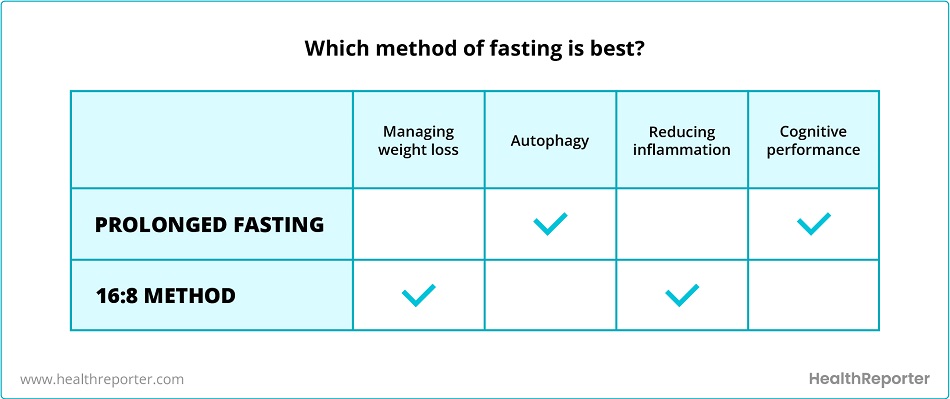
We couldn’t pick between the two with the above testing methods, as both diets have their strengths and weaknesses in certain areas. The 16:8 method is more commonly used and potentially carries with it less risk than prolonged fasting, so we may lean toward this approach. Prolonged fasting has a range of benefits but may be harder to stick with initially.
As always, you should always consult your doctor before trying any method of fasting, as they can come with some risks to certain groups of people.
Sources:
YouGov, Good To, NCBI, NCBI 2, NCBI 3, Longevity Technology, NCBI 4, Fasting.com, Simple Life, Medicine Net, PubMed, T and F Online, NCBI 5, Cell, Nature.com, Yales Education, Science Direct, Join Zoe, Journals.Muni, NCBI 6, Cell 2
Conclusion
Keto dieters are often looking for delicious foods to include in their diet while keeping carbohydrate consumption to a minimum. Cheese is not to be missed, as it provides plenty of fat and protein, among other nutrients. It’s primarily low-carb, so it won’t end ketone production.Still, you should moderate how much cheese you eat. Due to high amounts of saturated fats, eating too much can negatively impact your heart health. Select your favorite keto cheeses and incorporate them safely into a clean keto diet that prioritizes good fats.

















































 Select your language:
Select your language: 








